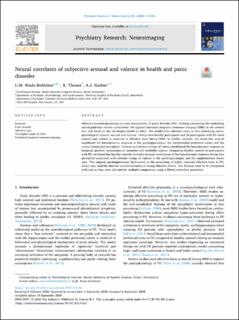Bitte benutzen Sie diese Kennung, um auf die Ressource zu verweisen:
https://doi.org/10.21256/zhaw-20585| Publikationstyp: | Beitrag in wissenschaftlicher Zeitschrift |
| Art der Begutachtung: | Peer review (Publikation) |
| Titel: | Neural correlates of subjective arousal and valence in health and panic disorder |
| Autor/-in: | Wade-Bohleber, Laura Maria Thoma, R. Gerber, A.J. |
| et. al: | No |
| DOI: | 10.1016/j.pscychresns.2020.111186 10.21256/zhaw-20585 |
| Erschienen in: | Psychiatry Research: Neuroimaging |
| Band(Heft): | 305 |
| Heft: | 111186 |
| Erscheinungsdatum: | 10-Sep-2020 |
| Verlag / Hrsg. Institution: | Elsevier |
| ISSN: | 0925-4927 1872-7506 |
| Sprache: | Englisch |
| Schlagwörter: | Affective faces; Circumplex model of affect; Functional magnetic resonance imaging; Panic disorder |
| Fachgebiet (DDC): | 616.8: Neurologie und Krankheiten des Nervensystems |
| Zusammenfassung: | Aberrant emotion processing is a core characteristic of panic disorder (PD). Findings concerning the underlying neural pathways remain inconsistent. We applied functional magnetic resonance imaging (fMRI) in the context of a task based on the circumplex model of affect. This model links affective states to two underlying neurophysiological systems: arousal and valence. Twenty-two healthy participants and 20 participants with PD rated arousal and valence in response to affective faces during fMRI. In healthy controls, we found that arousal modulated the hemodynamic response in the parahippocampus, the ventromedial prefrontal cortex and the cuneus during face perception. Valence and extreme ratings of valence modulated the hemodynamic response in temporal, parietal, somatosensory, premotor and cerebellar regions. Comparing healthy controls to participants with PD, we found that healthy controls showed a stronger modulation of the hemodynamic response during face perception associated with extreme ratings of valence in the parahippocampus and the supplementary motor area. This suggests parahippocampal dysfunction in the processing of highly valenced affective faces in PD, which may underlie aberrant contextualization of strong affective stimuli. Our findings need to be interpreted with care as they were adjusted for multiple comparisons using a liberal correction procedure. |
| URI: | https://digitalcollection.zhaw.ch/handle/11475/20585 |
| Volltext Version: | Publizierte Version |
| Lizenz (gemäss Verlagsvertrag): | CC BY-NC-ND 4.0: Namensnennung - Nicht kommerziell - Keine Bearbeitungen 4.0 International |
| Departement: | Angewandte Psychologie |
| Organisationseinheit: | Psychologisches Institut (PI) |
| Enthalten in den Sammlungen: | Publikationen Angewandte Psychologie |
Dateien zu dieser Ressource:
| Datei | Beschreibung | Größe | Format | |
|---|---|---|---|---|
| 2020_Wade-Bohleber_etal_Neural-correlates.pdf | 1.57 MB | Adobe PDF |  Öffnen/Anzeigen |
Zur Langanzeige
Wade-Bohleber, L. M., Thoma, R., & Gerber, A. J. (2020). Neural correlates of subjective arousal and valence in health and panic disorder. Psychiatry Research: Neuroimaging, 305(111186). https://doi.org/10.1016/j.pscychresns.2020.111186
Wade-Bohleber, L.M., Thoma, R. and Gerber, A.J. (2020) ‘Neural correlates of subjective arousal and valence in health and panic disorder’, Psychiatry Research: Neuroimaging, 305(111186). Available at: https://doi.org/10.1016/j.pscychresns.2020.111186.
L. M. Wade-Bohleber, R. Thoma, and A. J. Gerber, “Neural correlates of subjective arousal and valence in health and panic disorder,” Psychiatry Research: Neuroimaging, vol. 305, no. 111186, Sep. 2020, doi: 10.1016/j.pscychresns.2020.111186.
WADE-BOHLEBER, Laura Maria, R. THOMA und A.J. GERBER, 2020. Neural correlates of subjective arousal and valence in health and panic disorder. Psychiatry Research: Neuroimaging. 10 September 2020. Bd. 305, Nr. 111186. DOI 10.1016/j.pscychresns.2020.111186
Wade-Bohleber, Laura Maria, R. Thoma, and A.J. Gerber. 2020. “Neural Correlates of Subjective Arousal and Valence in Health and Panic Disorder.” Psychiatry Research: Neuroimaging 305 (111186). https://doi.org/10.1016/j.pscychresns.2020.111186.
Wade-Bohleber, Laura Maria, et al. “Neural Correlates of Subjective Arousal and Valence in Health and Panic Disorder.” Psychiatry Research: Neuroimaging, vol. 305, no. 111186, Sept. 2020, https://doi.org/10.1016/j.pscychresns.2020.111186.
Alle Ressourcen in diesem Repository sind urheberrechtlich geschützt, soweit nicht anderweitig angezeigt.